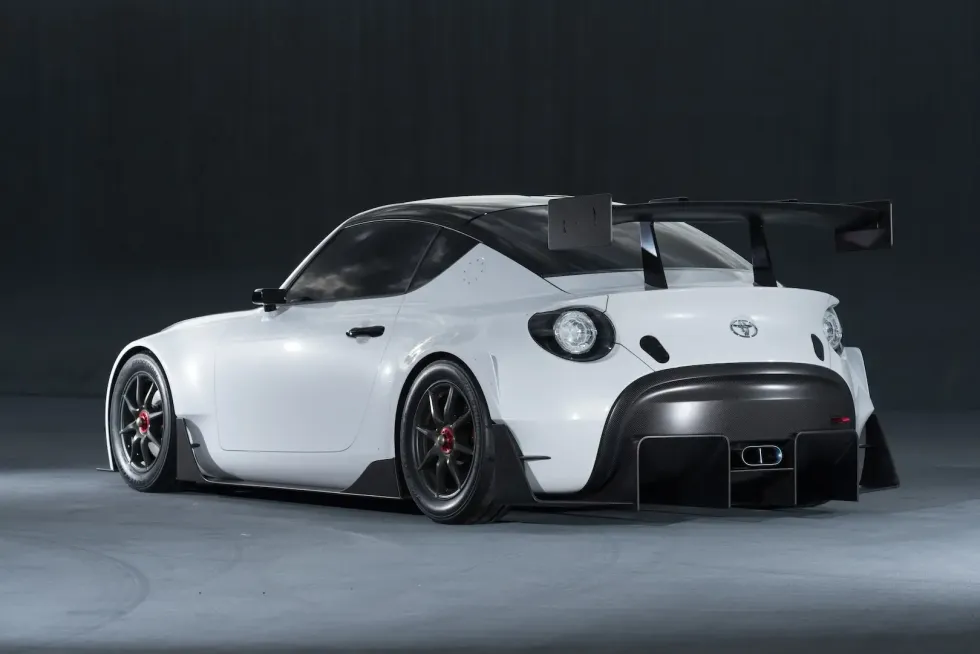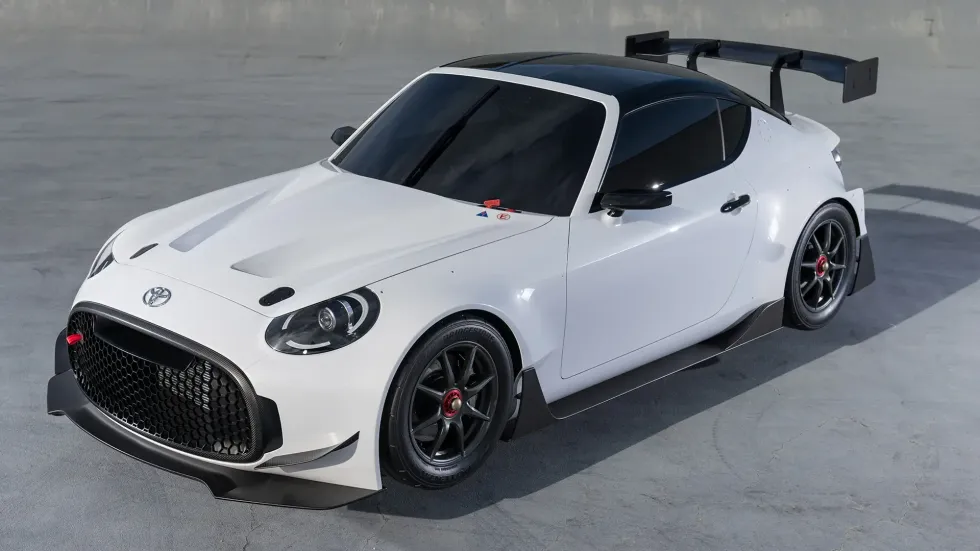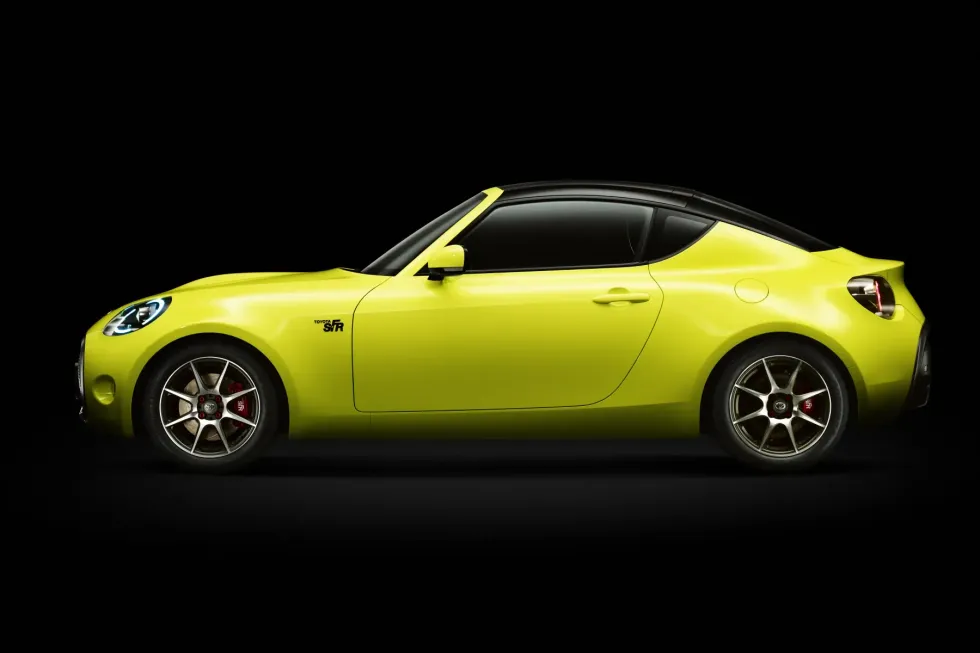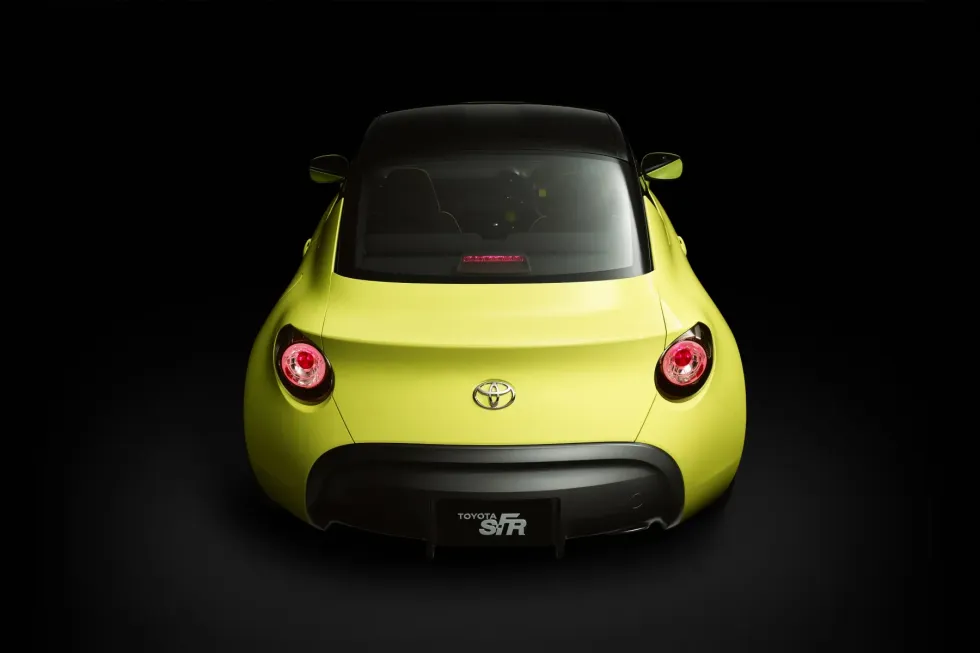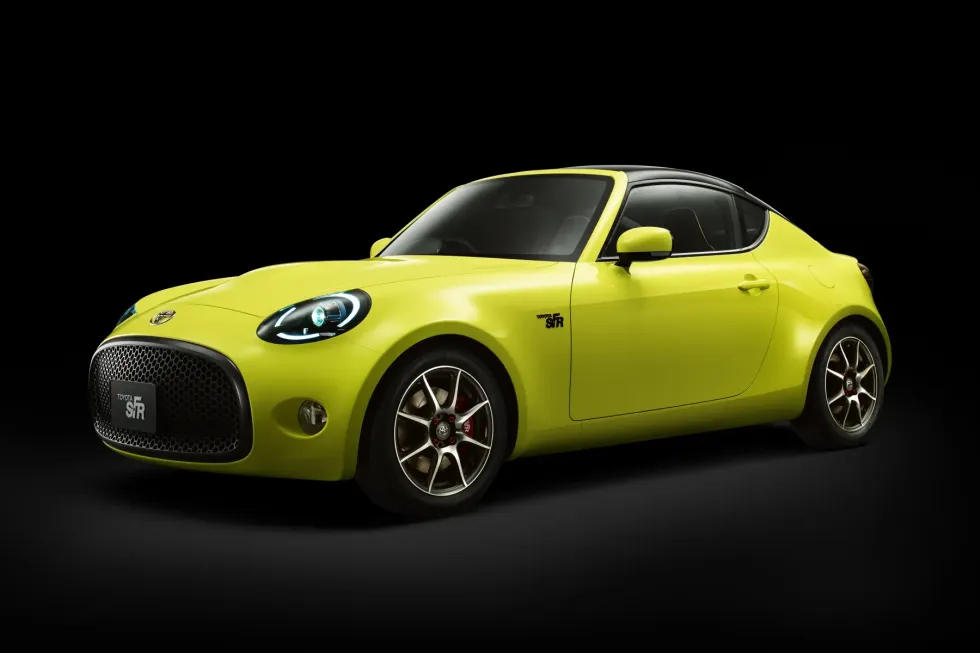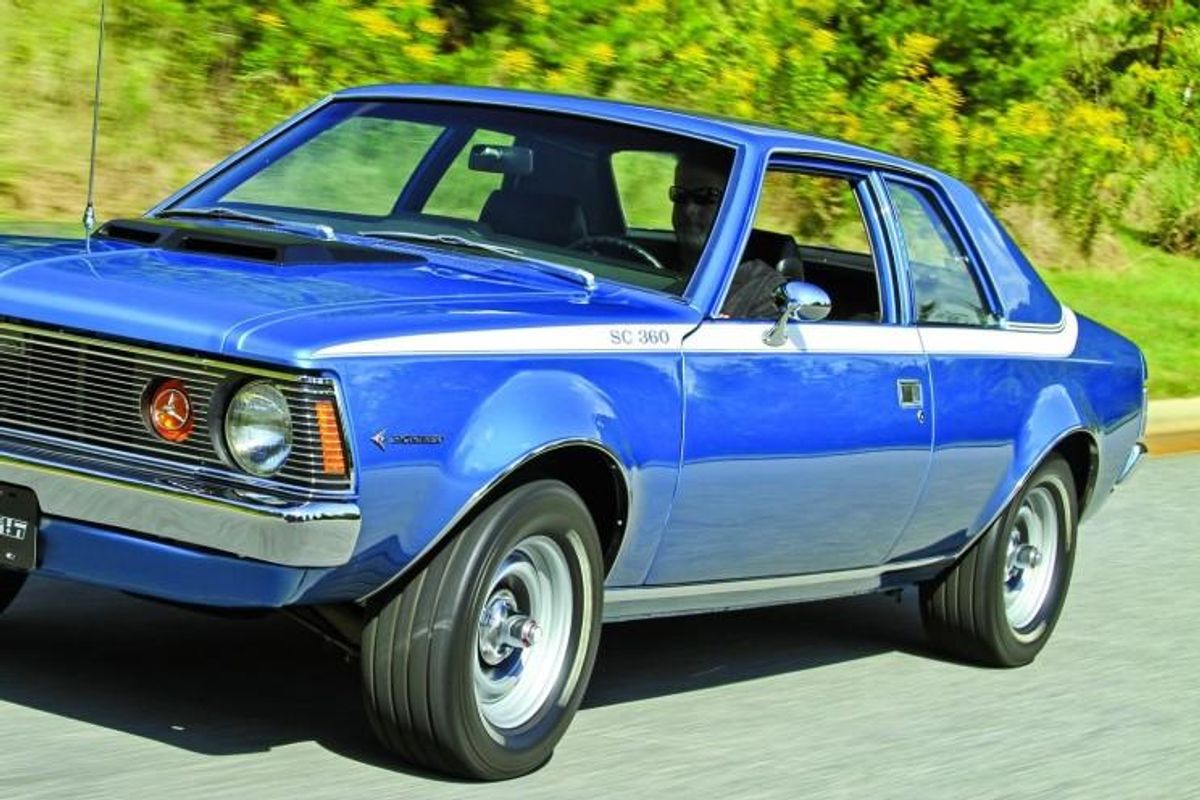
Buy
Resources
Entertainment
Magazine
Community
In This Article
Category:
Muscle Cars
While it never offered the marquee high-performance engines in the vein of the Street Hemi, Super Cobra Jet or Stage 1, AMC built muscle cars that were nonetheless competitive with the mid-range performers from its Big Three competitors-on the street and track or with the checkbook.
Special models such as the 1969 SC/Rambler and 1970 Rebel "The Machine" blended performance with the visual distinction that characterized the era. By 1971 muscle cars were declining sharply and so was AMC's fortune. The company was betting big on segment-transforming vehicles such as the Gremlin and, later, the Pacer, so there were precious few dollars leftover for frivolous specialty performance models that added essentially zilch to the bottom line.
Nevertheless, AMC had strong V-8 engines in the 360 and 401, along with a raft of proven supporting components such as the Twin-Grip rear axle. It didn't take much, then, to continue offering strong performance options in cars such as the Javelin. The same went for the almost invisible Hornet, which was introduced for 1970 (replacing the Rambler), but hadn't made much of a splash in the crowded compact market. About 100,000 were built that first year, but Chevy sold more than three times as many Novas.
Raiding the parts pins to build a performance-oriented, "sizzle" model was about as cost-effective as it got, and that's how the Hornet SC/360 was born. A two-barrel-fed version of the 360 was standard and rated at 245 horsepower. Ponying up another $199 for the Go Pak brought a four-barrel carb that raised output to 285 horses. It also added a Ram Air induction system fed by a distinctive matte black hood scoop, as well as dual-exhaust, a handling package, tachometer and Polyglas white-letter tires. The limted-slip Twin Grip rear axle was another $43 option and regardless of the optional Go-Pak, all SC/360 models--the "SC" stood for Super Coupe--featured a white upper body stripe.
With 285 horses, nearly 400-lb.ft. of torque and a shipping weight of around 3,300 pounds, the SC/360 was no slouch. It was a 14-second car off the showroom floor, and it didn't take much to make them much quicker.
AMC's vision for the SC/360 was ambitious, with plans to produce up to 10,000 of them, but market conditions and unexpectedly high insurance premiums conspired against it. When the dust settled on the 1971 model year, only 784 were built. It was a disappointing result to a promising muscle car, but the low production count makes the few remaining examples that much rarer sights today.
The 360 engine was rebuilt to stock standards, but required tracking down the Motorcraft 4300 four-barrel carburetor that was missing when the car was acquired. One of the chrome rocker covers had to be located, and the original cast-iron exhaust manifolds were replaced, as the corroded originals were beyond saving.
For Jim Pisano, a Long Island resident with a lengthy list of muscle cars that have resided in his garage over the years, it was the SC/360's rarity that sparked his interest. He'd never owned an AMC before and found himself less-enthused by the succession of Chevelles and other mainstream muscle cars he'd owned.
"I had about 30 cars in my collection at one time and was a regular at all the auctions," he says. "It got to the point, however, that I felt like I'd seen it all and won it all with the same cars you see at show after show. I kind of dropped out of it for a while and stopped buying cars, because there wasn't anything that was interesting any longer."
That was before he ran across an SC/360 in an online auction.
"I just didn't know what it was or what it was about," says Pisano. "It piqued my interest, and I started researching it. When I found out how few were made and how unique they were, I knew I had to have one."
With only 784 made and perhaps less than 100 remaining, finding one proved easier said than done. Pisano spent years seeking one out, before stumbling on one unexpectedly in the Bronx.

"I'd been invited to attend a classic car auction in an old BMW dealership, but there was nothing there I was interested in," he says. "It was the same cars I'd grown bored with, but after it was over, I left for lunch with the gentleman who ran the auction. We were walking through the basement of the dealership and there, over in the corner, was a blue SC/360. I couldn't believe it."
Pisano immediately asked about purchasing the car, but was met with skepticism.
"It belonged to someone else who'd left it there a number of years earlier," he says. "My acquaintance wasn't even sure he could contact him any longer--and besides that, he thought I was nuts for wanting a car that had obvious issues. It was a Bondo bucket."
Nevertheless, Pisano pressed his acquaintance to dig up the contact info, and they succeeded in tracking down the owner. A deal was struck and the car was soon in Pisano's possession, but that was only the beginning of a restoration journey that would consume more than a decade. Before turning the car over to a shop for a full rotisserie resto, Pisano spent the first several years tracking down parts.
"It needed almost everything," he says. "The original carburetor and other engine parts were gone. The hood scoop was broken. The grille was cracked. You name it and it needed it, but I was determined to make the car completely authentic, so it became a quest to find the correct parts. I made a parts list and got started."
Rust-free bumpers were tough to locate, along with the grille and passenger-side taillight lens, but Pisano says the biggest parts challenge of them all was a single, solitary center cap for the styled steel wheels.
"It took me two and a half years to track one down," he says. "I had three, but that fourth one was like trying to find the holy grail."
He finally found it in a salvage yard near Harrisburg, Pennsylvania, where he'd been attending a Mecum auction. It was a stroke of luck, and after accumulating most of the hard parts, Pisano set about searching for the right restoration shop. After several recommendations and an interview with the shop's owner, he shipped the car to The Winning Collection, in Asheville, North Carolina, where it would spend the next six years.
"With so few replacement parts available, they had to fabricate virtually all of the necessary sheetmetal, and my brother even helped by fabricating one of the front fenders," says Pisano. "It was a mammoth undertaking that the guys in the shop executed perfectly. I couldn't be happier with the results."
Unfortunately, The Winning Collection recently closed its doors, but the legacy of their craftsmanship is evident in Pisano's stunning car. It's one of 578 built with the Go-Pak and wears the original B6 Electric Blue Metallic exterior color. It is also a "Shift Command" automatic car, which paired the 360 engine with a Borg-Warner three-speed automatic, and was originally equipped with the 3.15-geared Twin Grip axle.
Inside, it's black vinyl throughout. The dash pad had to be redone, along with the door panels, headliner and upholstery. Some of the gauges weren't working and neither was the original radio. Pisano wasn't exaggerating when he said the car needed everything.
The challenge is part of the reward in a restoration, but not every element of the SC/360's refurbishment required dozens of hours of fabrication or years of searching. Some of it was downright easy.
"The white rally stripe was a cinch," he says.
"With less than 1,000 cars built and something like 80 of them left, I figured there would be no way of finding one, but it's reproduced. I found it immediately online. Go figure."
Pisano hasn't put many miles on the car since the restoration was completed, but plans to hit the major AMC events throughout 2017.
"I've met a lot of great people while tracking down parts and researching the car," he says. "I want to share what all the work was about and celebrate one of the rarest and most unique muscle cars ever built."
OWNER'S VIEW
Somebody asked me why I was bothering with the restoration on an AMC that was in really rough shape, and my reply was, "Because no one else is." This car does it for me in a way that others don't. It's rare and unique, and there's always a story to tell with it. And there's a real feeling of satisfaction that comes restoring a car that's such a challenge. With Mustangs and Chevelles, virtually all of the parts are available, but with the SC/360 it's a mental game as much as a physical restoration. You've got to use your head to find the parts and work out all the little details. It's taxing but fun at the same time. It's been a great experience.--Jim Pisano
Recent
Toyota
Toyota is pulling out all the stops to compete with the likes of affordable sports cars like the Mazda Miata. The automaker reportedly plans to put the S-FR concept car, originally debuted in 2015, into production. With potential release dates slated for early-2026 or early-2027, perhaps Miata may not always be the answer.
A new report out of Japan confirmed that the Toyota S-FR concept, first seen at the 2015 Tokyo Motor Show, will hit the market to challenge the entry-level sports car segment. Forbes backs up this claim via its print edition of Best Car. According to the report, the Toyota S-FR will be produced in partnership with Daihatsu, a wholly owned subsidiary of Toyota, and Suzuki, of which the Toyota Motor Corporation owns 4.94 percent.
From the sounds of it, the S-FR will share a platform with the Daihatsu Vision Copen that was revealed at the 2023 Tokyo Mobility Show. It will supposedly feature the same two-plus-two seating as displayed in the concept, but will be even smaller and lighter than the Toyota 86 model.
The Toyota S-FR will reportedly get its power from a turbocharged three-cylinder engine that will send around 150 horsepower to the rear wheels. If these figures sound familiar, you may have also heard the rumors about Toyota reviving the Starlet with a GR performance version that has similar specs; a 1.3-liter engine producing 150 horsepower.
Like most concept cars, the S-FR’s design will see some changes before production, in this case reports point specifically to a smaller grille and altered headlights. Whether or not the production model will incorporate the concept’s aero elements is unknown.
Toyota’s target MSRP of $22,700 for the S-FR could potentially beat out the Mazda Miata by around $6,000. Whether or not the S-FR will be sold in the States to potentially compete with Toyota’s existing GR86 model’s sales is also, sadly, unknown, but we have our fingers crossed.
Keep reading...Show Less
What if I told you that not all muscle cars are from Detroit? No, I’m not talking about any of the rebellious machines from Kenosha. I’m talking about Newport Pagnell. Where exactly is Newport Pagnell you ask? It’s about 50 miles northwest of London, and the traditional home of Aston Martin, where thousands of its cars were built between the mid-1950s through 2007. Let’s take a look at this 1978 Aston Martin V8 Series 3 currently offered on Hemmings Auctions as a prime example of a non-Detroit muscle car.
How does the AMV8 stack up as a muscle car? Let’s count the ways: It’s got a booming, high-performance V8 under the hood that sends power to the rear wheels—and the rear wheels only. It’s a two-door coupe with a long hood and a fastback roof. It has a big hood scoop needed to clear a quartet of Weber two-barrel carburetors. It even has a Chrysler TorqueFlite automatic transmission for that authentic Yankee feel.

Rather than a lightweight sports car, the Aston Martin V8 is better considered a GT car, which seems to have a lot in common with American muscle cars. Even with aluminum body panels, the rather substantial Aston had a curb weight just a hair over 4,000 pounds, making it several hundred pounds heavier than a 1969 Dodge Charger R/T. It’s worth noting that despite being measurably smaller than the Charger, both cars share very similar proportions, with their long hoods, fastback rooflines, and short rear decks. An even closer comparison comes in the form of a ‘67 Ford Mustang, again with similar proportions but also the Aston having a wheelbase and overall length, width, and height very close to the American pony car.
The 1978 Aston Martin V8 is frequently referred to as a Series 3 since it was derived from the DBS, a model that launched in 1967 with an inline-six engine that was followed by the DBS V8, with a fuel-injected V8 engine. Both versions of the DBS were sold alongside each other into 1972, when, during the model year, the simply named V8 model supplanted both. With an updated front end that included a grille shape more reminiscent of Aston Martins past and a pair of headlamps rather than four, these interims V8s were considered Series 2 cars.

In 1973, Aston Martin dumped what had turned out to be a problematic mechanical fuel-injection system, instead opting for four Weber carburetors for its 5.3-liter V8. Multiple carburetion gives it good company with the likes of a Mopar 440 Six-Pack or Pontiac Tri-Power. That carburetor setup required additional hood clearance that resulted in the large scoop worn by such cars, though it was non-functional in terms of letting in any additional air to the intake.
The rest of the engine department takes a big departure from the standard American iron-block, overhead-valve setup. Aston Martin’s V8 featured all-aluminum construction and dual overhead camshafts on each cylinder head, driven by dual chains. Yes, it had hemispherical combustion chambers, even with just two valves per cylinder. Engineers specced a forged crankshaft and forged chrome-moly connecting rods.

Output for 1978 was estimated at 310 horsepower and 320 lb-ft of torque—pretty substantial numbers for a car built during the oil crisis era and before engineers had leveraged electronic fuel injection to win the battle against emissions regulations. In accordance with its muscle car vibe, most AM V8s of the period were equipped with a TorqueFlite three-speed automatic, complete with Mopar factory ratios of 2.45:1, 1:45:1 and 1:1, along with a limited-slip rear differential. A 3.31 final-drive ratio was standard, with 3.54:1 optional. A five-speed manual was available.
Distinctions from Detroit grow once you step inside an Aston Martin V8, which was essentially a handmade car, with very low production numbers. Each of the four seats was covered in leather, a material that extended to the door trim, steering wheel, shift knob and even the center console surround. Carpets were wool. Given its high price and object of luxury aspirations, each car was also packed with plenty of sound insulation to isolate occupants from road noise. Power assistance for the brakes and steering was standard, as were air conditioning, power windows and power locks.

With a 0-60 mph time of “about six seconds,” according to Aston Martin literature of the time, along with a top speed over 150 mph, the AM V8 was in nearly a class by itself. Torque wasn't quite like that of an unrestrained big block American V8 from the peak muscle car era, but the Aston Martin’s V8 engine still delivered power with a swift rush towards a redline over 5,000 rpm, though no such actual red line is indicated on the tach. Suspension included unequal-length control arms up front with an anti-roll bar and De Dion rear axle with parallel trailing arms and watt linkage in the rear. Coil spring were at all four wheels, as were disc brakes, with the rear disc inboard. Not designed to tackle a tight road course, the AM V8 was still noted as a competent high-speed handler.
This 1978 Aston Martin V8 Series 3 features a silver metallic body with a red leather interior. The selling dealer indicates that it was purchased from the second owner who it is believed purchased it from the original owner as he aged out of driving in his 90s. The car appears to have been very well maintained, with the seller sharing that the engine, transmission, paint, body and interior are all “highly original.”

Other information to note on this AMV8 are a slew of services performed last fall, including a “full tune-up,” rebuilt carburetors, new spark plugs and filters, new battery and an alternator rebuild. Everything is asserted to be functioning properly with the car seemingly ready to drive anywhere.
As one of less than 1,000 Series 3 examples made, this 1978 Aston Martin V8 coupe offers a uniquely British take on big V8 performance in a midsize car—a muscle car, but with a different accent.
Head on over to Hemmings Auctions and take a closer look for yourself.
Keep reading...Show Less


